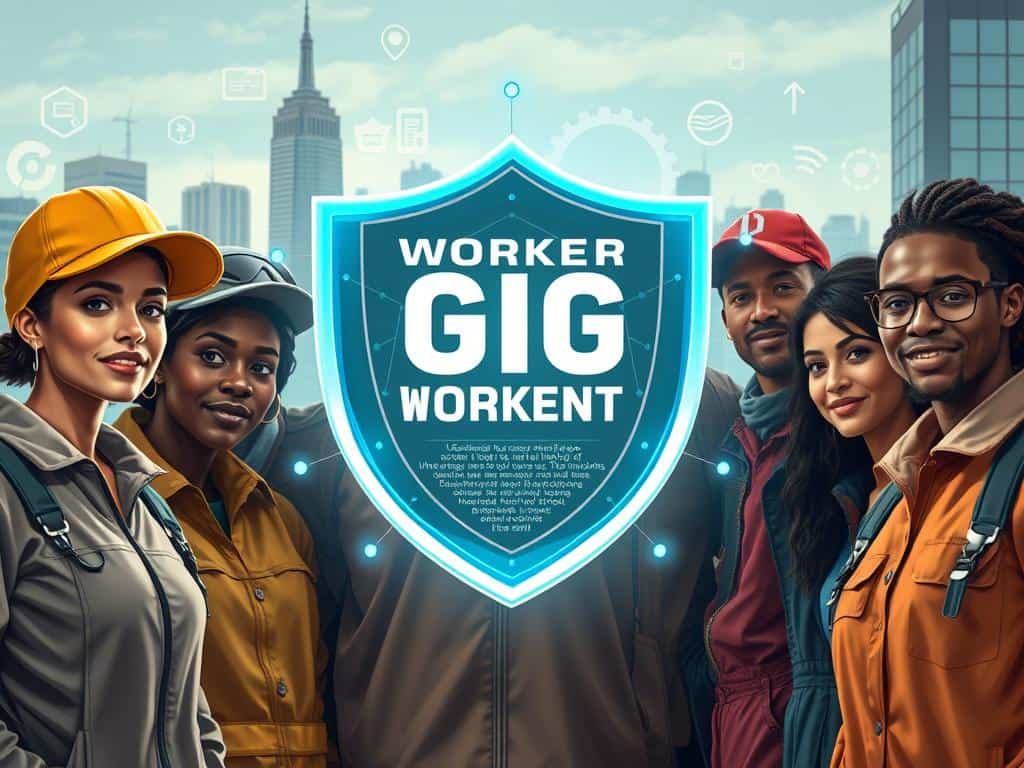More than a third of American adults are diving into gig work, showcasing its booming growth. This trend is reshaping our workforce, offering more freedom on when and where to work. With two out of three companies turning to freelancers to save on labor, the movement is growing fast. Smaller businesses, in particular, are looking to technology to find and offer better opportunities for gig workers. This article will explore six key digital trends that are changing the gig economy. We’ll look into everything from specialized gig platforms to blockchain technology. These advances promise to revolutionize how we view and perform gig work.
Key Takeaways
- 36% of American adults are engaged in gig work, reflecting significant growth in the sector.
- Freelance contracts are increasingly being utilized by major companies to reduce labor costs.
- Blockchain technology is poised to enhance transaction security and trust within the gig economy.
- Specialized gig markets catering to niche skills are predicted to expand.
- The collaboration between gig workers and traditional businesses is expected to increase significantly.
The Rise of Remote Work and its Impact on the Gig Economy
The rise of remote work has changed the gig economy, giving workers more flexible opportunities. Around 35% to 40% of U.S. workers were in the gig economy by the end of 2020. This change fits well with desires for work-life balance, independence, and different ways to earn money.
With more remote jobs available, gig workers can now find jobs online that were once out of reach. This lets them work with clients all over the world.
Changing Work Models and Opportunities for Gig Workers
Traditional work models are changing, making freelance work more diverse and easy to get into. Many people join the gig economy for extra money or as their main income. This is especially true for those wanting better pay or moving away from regular jobs.
This flexible way of working is great for people with different needs. It suits caregivers, people with disabilities, or those without formal degrees well. Businesses also find hiring gig workers scalable and cost-effective. This benefits everyone and creates a lively setting.
The Role of Technology in Facilitating Remote Work
Technology has played a key role in the growth of remote work and the gig economy. Cloud computing and teamwork platforms make jobs more reachable, letting gig workers operate from anywhere. This technology helps companies find global talent easily, matching projects with suitable freelancers.
As the market grows, the need for skilled gig workers increases. This is fueled by the younger generation, who value flexible work setups.
Shifts in Worker Rights and Benefits Within the Gig Economy
The gig economy’s landscape is changing, especially in terms of worker rights and benefits. This fast-growing sector offers both good and bad for gig workers. One key issue is making sure workers get fair pay and enough protection.
The Growing Demand for Fair Compensation
Gig workers increasingly want fair pay. Many of them, involved in online jobs, earn below the minimum wage after expenses. For instance, a study found that Uber drivers make an average of $9.21 an hour after costs. This highlights the urgent need for better pay and clear payment models in the gig economy.
Advocacy for Enhanced Protections and Benefits
There’s a strong push for better working conditions and pay for gig workers. The Gig Workers Collective is one group fighting for these improvements. However, without the power to negotiate collectively, many gig workers lack access to essential benefits like health insurance and retirement plans. While some regions are adopting new labor laws to help gig workers, achieving widespread benefits remains tough.
Impact of Labor Regulations on Gig Workers
Labor regulations affecting gig workers are increasingly important. Efforts are being made to craft laws that recognize the special circumstances of gig work. Though some positive changes have happened, much work still needs to be done. California’s Assembly Bill 5, for example, faced strong opposition, leading to more complex laws. As the gig economy grows, crafting clear and fair regulations will be key to protecting workers.

Conclusion
The landscape of the gig economy is always changing, thanks to digital trends and more remote work. Looking at the gig sector, it’s clear that while there are more jobs, struggles remain. Many gig workers find it hard to make enough money. They often work long hours without key benefits like sick pay.
This situation shows how important worker rights are in the gig economy. As this job sector grows, everyone involved needs to work together. This includes workers, businesses, and the people who make our laws. They should make sure everyone is treated fairly and protected.
The gig economy can help people who have trouble finding regular jobs. It lets them work when they can and gain new skills. Yet, we have to watch how it affects things like social ties and fairness.
As we move forward, making sure workers are treated right will be key. We need a fair system that helps everyone. By fixing current problems and pushing for better rules, we can make the gig economy better for all workers in our digital age.